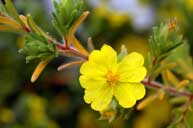In Flower This Week
A news sheet prepared by a Gardens' volunteer.
Numbers before each plant refer to temporary IFTW labels in the gardens.
Numbers in square brackets [ ] refer to garden bed Sections. Plants in flower are in bold type.
View past issues of 'In Flower This Week'.
7 January 2015
Hibbertia patens click for larger image |
Take a walk from the Visitor Information Centre (VIC) along the Main Path to see some New Year’s flowers.
- On the left across from the VIC look up to see Pandorea jasminoides [Section 212], a massive woody vine with plenty of pink bell flowers and shiny light green leaves. Also known as Bower of Beauty, the plant is native to New South Wales and Queensland, and forms large pointed pods filled with papery seeds.
- On your right and left at the entrance to the VIC in pots is Blandfordia grandiflora [Section 221], or Christmas Bells,with large fluted red bell flowers tipped with yellow on thin stems above linear foliage. It is native to south-eastern Australia.
- Further along on your right is Spyridium burragorang [Section 174], with prominent white bracts and tiny central flowers. As the name suggests, the plant is confined to the Lake Burragorang district in New South Wales and is considered rare in the wild.
- Go across the bridge to see on your left Hibbertia patens [Section 131], showing off bright green foliage with yellow flowers. This plant grows naturally on the east coast of Australia near the Queensland/New South Wales border.
- Go up the hill following the Main Path to see on your left a small tree with drooping foliage. Babingtonia pluriflora [Section 30] is covered in tiny white flowers that are often surrounded by a cloud of beetles. This plant is widespread on the coast and coastal ranges south from Port Stephens in New South Wales into Victoria.
- Further on your right is Stenocarpus angustifolius [Section 30], a medium-sized bush with lance-shaped light green foliage in attractive contrast to lemon yellow clusters of flowers that are highly attractive to many insects. In the wild this plant is found in Cape York, Queensland in sandy granite creek beds of dry eucalypt forest.
- Grevillea ‘LadyO’ [Section 24] on your left is a medium sized spreading shrub with red clusters of flowers on a neat bush. Local plant breeder Peter Ollerenshaw produced this hybrid by crossing Grevillea victoriae with G. rhyolitica.
- Grevillea sericea [Section 26], or Silky Grevillea, is a shrub endemic to New South Wales. It has many clusters of pink spider-like flowers.
- On your right is Persoonia acerosa [Section 26], or Needle Geebung, with deep gold spiky flowers at the ends of bright green foliage. It occurs in New South Wales from the central Blue Mountains south to Hill Top.
- Close to the Persoonia on your right is Grevillea ‘Canterbury Gold’ [Section 26], a hybrid between Grevillea victoriae and a prostrate form of G. juniperina. This hardy bird-attracting shrub has bright yellow spider-like flowers.
- Also on your right is Adenanthos sericeus [Section 26], commonly known as Woolly Bush, a shrub native to the south coast of Western Australia. It has small tubular red/orange flowers on a medium bush with silky grey-green foliage.
- Low on the right is Banksia petiolaris [Section 26], a ground-hugging banksia with yellowish cones. This plant occurs in the wild on a stretch of the south coast of Western Australia east and west of Esperance.
- As you enter the Sydney Basin on the left and right is Crowea exalata [Section 112], with pretty pink star flowers on soft foliage.
- Banksia serrata [Section 112], or Saw Banksia, on the left has very large yellowish-green cones with grey tips. The trunk has a bubbly texture which becomes more noticeable as the tree ages.
- Correa glabra var. glabra [Section 112] is around to your right, a large bush with many green tubular flowers.
Rosalind Walcott
![Director of National Parks [logo]](../../../../images/dnp_90px.gif)







